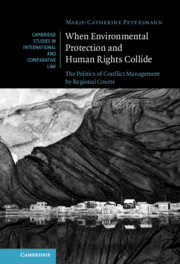 When Environmental Protection and Human Rights Collide
When Environmental Protection and Human Rights Collide Book contents
- When Environmental Protection and Human Rights Collide
- Cambridge Studies in International and Comparative Law 172
- When Environmental Protection and Human Rights Collide
- Copyright page
- Contents
- Acknowledgements
- Table of Cases
- Introduction
- Part I Constructing Synergies: Framing the Environment–Human Rights Interface
- Part II Conflict Mediation through Universalisation
- Conclusion
- Bibliography
- Index
- Cambridge Studies in International and Comparative Law
Part I - Constructing Synergies: Framing the Environment–Human Rights Interface
Published online by Cambridge University Press: 20 October 2022
- When Environmental Protection and Human Rights Collide
- Cambridge Studies in International and Comparative Law 172
- When Environmental Protection and Human Rights Collide
- Copyright page
- Contents
- Acknowledgements
- Table of Cases
- Introduction
- Part I Constructing Synergies: Framing the Environment–Human Rights Interface
- Part II Conflict Mediation through Universalisation
- Conclusion
- Bibliography
- Index
- Cambridge Studies in International and Comparative Law
Summary
This first part explores the origins of the relationship between environmentalism and human rights and traces the evolution of this encounter through a historical lens. It analyses how concerns for environmental protection and human rights emerged as distinct aspirations that progressively evolved towards mutual integration into each other’s normative architecture, legal registers and institutional practices. By examining how the framing of the relationship between ‘Man and Nature’ changed over time and how these changes of perception were legally translated in international instruments, judicial decisions and doctrinal accounts, this part of the book thereby sheds light on a major paradigm shift that occurred in the 1960s, when environmental protection began to be framed as intrinsically intertwined with human rights concerns. This shift corresponds to the first explicit references to human rights in environmental instruments. The analysis unpacks how this radical turn in environmentalism was accommodated at three complementary levels: legislative, adjudicative and doctrinal. This produced a dominant account where environmental protection and human rights are viewed as synergistic and mutually reinforcing objectives, in disregard of the conflicts that also underpin this relation. This account thereby contributes to the literature that critically engages with liberal human rights-based approaches to environmental protection.
Keywords
- Type
- Chapter
- Information
- When Environmental Protection and Human Rights CollideThe Politics of Conflict Management by Regional Courts, pp. 15 - 112Publisher: Cambridge University PressPrint publication year: 2022


